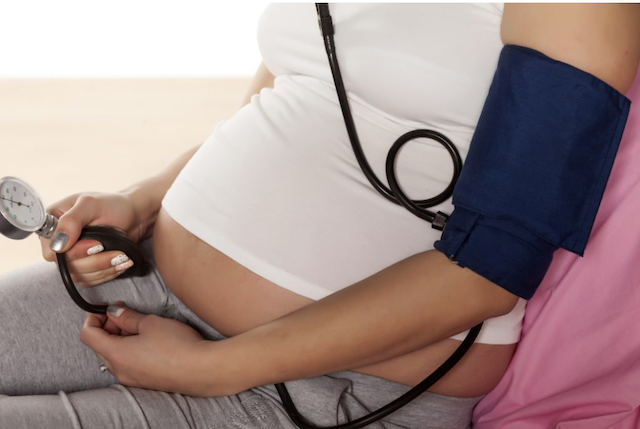Article
It’s time to give blood pressure monitoring to all pregnant moms
Remote blood pressure (BP) monitoring is a critical tool for reducing poor outcomes in high-risk pregnancies. Stakeholders across the maternal health space need to come together to provide it for all moms, regardless of risk.

The United States has the highest rates of maternal mortality in the developed world. Over 50% of those deaths occur in the postpartum period, and 60% of those deaths are preventable. Black women are 2-3x more likely to be victims of these statistics than their peers, regardless of income or status.
These facts are so ubiquitous that a quick Google search of any of them will bring up hundreds of hits. If we’re so aware of the issues, then why hasn’t the needle moved on outcomes?
Part of the problem is the sheer variety of causes — and they can’t be unilaterally abolished by the stroke of a pen on legislation.
We need to focus on fixing the issues that can help the most people in the shortest time, that don’t require decades of cultural and structural change to resolve.
We need to go after actionable targets, starting with preventable prenatal and postpartum deaths and the issues that can contribute to them, like hypertension.
Hypertensive disorders with onset during pregnancy are responsible for 7.8% of all pregnancy-related deaths, and that doesn’t take into consideration cardiovascular issues and other health problems to which hypertensive disorders of pregnancy (which occur in nearly 10% of all gestations) are often a precursor.
Maintaining a certain BP has been proven to directly affect the risk of hypertension and improve outcomes. In some cases, elevated BP is the only indication of a dangerous condition like preeclampsia. If a woman is only having her BP taken at her regularly scheduled prenatal visits, it is highly possible that high BP could go undetected.
During the postpartum period, the safety net is even worse — women typically do not see their doctor until a single follow-up appointment 6 weeks after giving birth. Many women fail to attend this appointment, and for some others, six weeks is already too late to catch life-threatening complications. A new mother who is normotensive at discharge can quickly become hypertensive, even if she experienced no BP complications before or during her pregnancy.
Every pregnant woman should be on BP monitoring, through and up to at least 6 weeks postpartum.

If we focus on BP, we can cut death rates overnight by giving patients more tools today; and incidentally, dramatically reduce the costs to health systems resulting from preeclampsia, preterm birth (directly correlated to preeclampsia), readmissions, and other costly complications related to hypertension.
Remote BP monitoring can also begin to solve some of the larger structural issues at play in maternal healthcare. The use of remote tools can extend the reach of overburdened physicians and provide access to care for women living in maternity care deserts. It can also address racial inequities in the system.
The benefits of monitoring BP during pregnancy have staying power. With good habits around BP developed during pregnancy, women are more likely to continue to watch and learn about their BP trends throughout their lives. Pregnancy is often a woman’s first encounter with the healthcare system and an ideal time to solidify good habits and behaviors.

So what’s holding us back from the wide-scale adoption of remote BP monitoring?
Providing a BP cuff to every single pregnant person would cost upwards of $200M — a steep price, yes. But compared to nearly $3B dollars in cost associated with preeclampsia? The $13B+ for preterm birth (a result of 15% of preeclamptic pregnancies)? The $500M in readmission costs for postpartum hypertension? And those costs don’t take into account the massive downstream societal costs of maternal death and morbidity.
Of course, the BP cuff is only a part of the solution. Data is only as effective as the infrastructure that makes it actionable. We need to invest in infrastructure that communicates that data back to stakeholders (in this case, clinicians) in actionable ways — infrastructure that supports diagnostic data, integrates clinical protocols, functions within existing workflows, and communicates across different data platforms.
This infrastructure already exists and has only become more sophisticated with the advent of the Internet of Things, but healthcare industry standards are stuck in the past, and they need to adapt to incorporate and support it.
Payers can play a major role in encouraging these industry shifts — several years ago, Medicare unbundled remote patient monitoring (RPM) reimbursement and is now fully supporting the use of digital tools to provide access to care for its patient population.
So why are commercial payers and Medicaid lagging behind? The pandemic has accelerated the inevitable shift to a more virtual model of care, and payers are in a position to cement that shift and affect immediate improvements on the system. We need widespread adoption of CPT codes, or new codes specifically designed for maternal health monitoring.
Congress has been proactive in proposing initiatives for improving maternal health, but the question of reimbursement is a major hurdle that they have yet to address. Any legislation directed to improvements in maternal health needs to include bottom-line incentives for providers — and incorporating the payer is a way to do that effectively.
About Author: Juan Pablo Segura, President, and Co-Founder of Babyscripts
Juan Pablo Segura founded Babyscripts in 2014 with the vision that internet-enabled medical devices would transform the delivery of pregnancy care. Juan Pablo has been named a Healthcare Transformer by the Startup Health Academy in New York and a Wireless Lifechanger by CTIA for his work in detecting problems in pregnancy faster. Juan Pablo is also the architect of the first "Prenatal Care Moonshot" focused on eliminating preterm birth by 2027 through mobile/digital technology and Babyscripts has been named Champions of Change in Precision Medicine by Barack Obama and the White House.
* The information available on ewellnessmag.com including - text, graphics, and other materials are for informational purposes only. Reliance on any information in ewellnessmag.com is at the user's own risk. Sponsored product placement may appear in the article. The visitor of this website acknowledges that the information available on or through ewellnessmag.com is not and is not intended to be a substitute for professional medical advice. Copyright © 2021 Brawo Press, Inc. All rights reserved.
Share article








You must be logged in to add a comment ... → Log in | Register